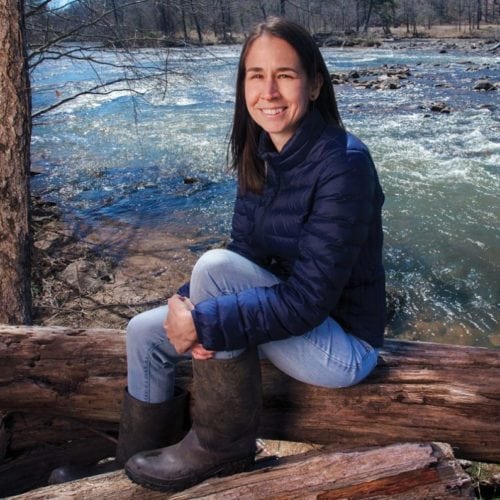Education
PhD, Marine Science, University of South Florida
BA, Biology, New College of Florida
Areas of Expertise
Research: marine microbial ecology, aquatic microbial ecology, pathogen ecology, climate change and waterborne disease, disease ecology
Teaching: public health microbiology, environmental microbiology, aquatic microbiology
Affiliations
Fellow in the American Academy of Microbiology
Member in American Society for Microbiology, Association for the Study of Limnology and Oceanography, and the American Meteorological Society
Courses Taught
Research in Dr. Lipp’s lab is centered around microbial ecology and environmental microbiology and its interface with both public and ecosystem health. She works on issues ranging from water and sanitation to climate change to coral disease ecology. Currently, her lab is focused on understanding population dynamics of bacterial pathogens in the context of their role in microbial community structure in aquatic systems and environmental factors that cause significant shifts in their abundance.
Selected Publications
Recent Lipp Lab Publications
Westrich, J.W., A.M. Ebling, W.M. Landing, J.L. Joyner, D.W. Griffin, and E.K. Lipp.. 2016. Saharan dust nutrients promote Vibrio bloom formation in marine surface waters. Proc Natl Acad Sci doi:10.1073/pnas.1518080113
Sutherland, K.P., B. Berry, A. Park, D.W. Kemp, K.M. Kemp, E.K. Lipp, and J.W. Porter. 2016. Coral disease etiologies as moving targets: a 20-year case study of white pox disease affecting Acropora palmata in the Florida Keys, 1994 – 2004. Philosophical Transactions of the Royal Society B 371: 20150205; DOI: 10.1098/rstb.2015.0205
Kemp, D.W., K.M. Kemp, A. Rivers, E.K. Lipp, J.W. Porter, and J. Wares. 2015. Spatial homogeneity of microbial communities associated within the surface mucus layer of the reef-building coral Acropora palmata. PLoS One 10 (12): e0143790
Hasan, N., C.J. Grim, E.K. Lipp, I.N.G. Rivera, J. Chun, B.J. Haley, E. Taviani, S.Y. Choi, M. Hoq, C. Munk, T.S. Brettin, D. Bruse, J.F. Challacombe, C. Detter, C.S. Han, J.A. Eisen, A. Huq, and R.R. Colwell. 2015. Deep-sea hydrothermal vent bacteria related to human pathogenic Vibrio species. Proc Natl Acad Sci 112: E2813-E2819.
Maurer, J., G. Martin, S. Hernandez, Y. Cheng, P. Gerner-Smidt, K.B. Hise, M. Tobin D’Angelo. D. Cole, S. Sanchez, M. Madden, S. Valeika, A. Presotto, and E.K. Lipp. 2015. Diversity and persistence of Salmonella enterica strains in rural landscapes in the southeastern United States. PLoS One 10 (7): e0128937
Joyner, J.L., K.P Sutherland, D. Kemp, B Berry, A. Griffin, J.W. Porter, M.B. Amador, H.K.G Noren and E.K. Lipp. 2015. Systematic analysis of white pox disease in Acropora palmata of the Florida Keys and the role of Serratia marcescens. Applied and Environmental Microbiology. 81: 4451-4457[Cover for issue]
Turner, J.T., L. Malayil, D. Guadagnoli, D. Cole and E.K. Lipp. 2014. Detection of Vibrio parahaemolyticus, Vibrio vulnificus and Vibrio cholerae with respect to seasonal fluctuations in temperature and plankton abundance. Environmental Microbiology 16: 1019 – 1028.
Joyner, J.L., D. Wanless, C. Sinigalliano and E.K. Lipp. 2014. Direct Detection of Serratia marcescens in the environment using quantitative real time PCR. Applied and Environmental Microbiology 80: 1679-1683.
Vereen, E., R.R. Lowrance, M.B. Jenkins, P. Adams, S. Rajeev, E.K. Lipp. 2013. Landscape and seasonal factors influence Salmonella and Campylobacter prevalence in a rural mixed use watershed. Water Research 47: 6075 – 6085.
Gonzalez Astudillo V., S. Hernandez†, S.L. Boone, E.K. Lipp, S. Shersthra, M.J. Yabsley. 2013. Spatial, temporal and intraspecific differences of haemoparasite infection and relevant selected physiological parameters of wild birds in Georgia, USA. International Journal for Parasitology: Parasites and Wildlife 2: 178 – 189.
Mote, B.K., J.W. Turner and E.K. Lipp†. 2012. Persistence and growth of the fecal indicator bacteria, enterococci, in natural estuarine plankton communities. Applied and Environmental Microbiology 78(8): 2569 – 2577.
Futch, J.C., D.W. Griffin, K. Banks and E.K. Lipp. 2011. Evaluation of sewage source and fate on Southeast Florida coastal reefs. Marine Pollution Bulletin 62 (11): 2308 – 2316.
Sutherland, K.P., S. Shaban, J.L. Joyner, J.W. Porter and E.K. Lipp. 2011. Human pathogen shown to cause disease in the threatened elkhorn coral Acropora palmata. PLoS One 6(8): e23468.
Malayil, L., J.W. Turner, K. Howe, B. L. Mote and E.K. Lipp. 2011. Evaluation of enrichment media for improved PCR-based detection of V. cholerae and V. vulnificus from estuarine water and plankton. Journal of Applied Microbiology 110: 1470 – 1475.
Looney, E., K. P. Sutherland and E.K. Lipp. 2010. Effects of temperature, nutrients, organic matter and coral mucus on the survival of the coral pathogen, Serratia marcescens, PDL100. Environmental Microbiology 12(9): 2479 – 2485.
Sutherland, K.P., J.W. Porter, J.W. Turner, B.J. Thomas, E.E. Looney, T. Luna, M.K. Meyers, J.C. Futch and E.K. Lipp. 2010. Human sewage identified as likely source of white pox disease of the threatened Caribbean elkhorn coral, Acropora palmata. Environmental Microbiology 12(5): 1122 – 1131.
Futch, J.C., D.W. Griffin and E.K. Lipp. 2010. Human enteric viruses in groundwater indicate offshore transport of human sewage to coral reefs of the Upper Florida Keys. Environmental Microbiology 12: 964 – 974.

